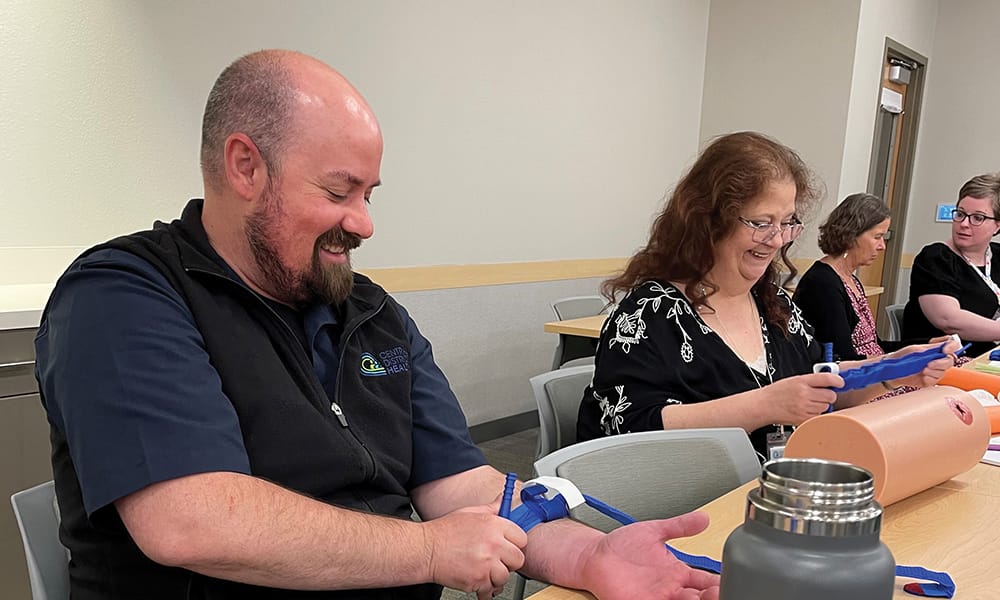How to keep guests and staff safe from common hazards
Parks and recreation employees play a crucial role in ensuring that public spaces are safe and enjoyable for visitors, despite daily exposure to numerous hazards. Whether it is a potential insect bite, inclement weather, or sun exposure, leaders must be aware of potential hazards and ways to avoid injury for themselves, staff, and parkgoers.
Mosquitos And Ticks
“Some insect bites are more than just pests,” says Jessica McClenahan, Central District Health (CDH) epidemiologist. “Mosquitos and ticks can transmit diseases like West Nile virus, Rocky Mountain Spotted Fever, and Lyme disease.”
Mosquitoes carry viruses or parasites from the blood of other contaminated animals and then spread the illness to humans through bites. To prevent mosquito bites, all staff should wear long sleeves, shoes, and socks when outdoors, and use insect repellent. To find the right repellent, use the Environmental Protection Agency’s insect repellent search tool. Leaders can help reduce mosquito-breeding populations by regularly reporting mosquito outbreaks to state or local health departments, and by emptying or covering items that hold standing water, which are breeding grounds for the insects.
Ticks also spread blood-borne diseases, but unlike mosquitoes, they can remain active even during colder months. Ticks thrive in grassy, brushy, or wooded areas and on some animals, depending on the species.
Unfortunately, there is no way to tell if an animal has rabies by looking at it, but there are common signs to look for:
- Overly friendly or aggressive behavior.
- Stumbling, shaking, and lack of coordination.
- Activity during a time that is abnormal, such as when bats or raccoons are active in the daytime.
Notify the local health department immediately if any member of the team knows (or suspects) they’ve encountered an infected animal. Department officials will help determine if there is any risk of rabies and work with a physician to determine if a vaccine is needed. Never touch a bat with one’s bare hands, and if scratched or bitten, seek medical attention. If anyone encounters a bat or bat carcass, save it in a container without touching it, and contact the district health department to arrange testing to rule out exposure to rabies.
“World Rabies Day is held every September 24 to raise awareness about rabies prevention,” O’Dell says. “Despite being completely preventable, rabies still claims lives every year.”
Sun, Heat, And Air Quality Hazards
“Unprotected sun exposure is a major risk factor for skin cancer, which is the most common form of cancer in the U.S. and one of the most preventable cancers,” says Alex Dominguez, CDH Community and Environmental Health project coordinator. “Outdoor workers have a higher risk for skin cancer. According to the American Academy of Dermatology, half of outdoor workers were sunburned in 2023, and one in 10 had sunburn with blisters — double that of the general population.”
To stay protected from the sun and reduce the risk of skin cancer, the AAD recommends that people seek shade when appropriate, wear sun-protective clothing and sunglasses with ultraviolet (UV) protection when possible, and consistently use a broad-spectrum, water-resistant sunscreen with an SPF of 30 or higher on all skin not covered by clothing.
“Remember that sunburn can occur even on cool or cloudy days,” Dominguez says. “UV rays are strongest during summer months from the late morning through mid-afternoon, but you need to practice sun safety all year.”

In addition to burns and skin cancers, increased sun exposure can lead to heat stress—and without prompt treatment, it can become heat stroke, a life-threatening condition. With increased exposure to the elements increasing risk, be sure that teams recognize the signs and symptoms of heat stress and know how to immediately reverse these conditions. If anyone experiences heavy sweating with clammy skin, muscle cramps, fatigue, dizziness, headache, nausea, or vomiting, they should do the following:
- Go to an air-conditioned or shaded place and lie down.
- Loosen clothing, take small sips of water, and slow their breathing.
- Seek medical help if they vomit, or if symptoms last more than an hour or get worse.
All staff and patrons should protect themselves from heat stroke by dressing appropriately, taking frequent breaks, and drinking at least one cup of water every 15 to 20 minutes to replace water lost in the heat. Avoid drinking sugary or caffeinated drinks, such as juices, soft drinks, or coffee and tea, since they contribute to faster dehydration.
Reducing exposure is the best defense against tick-borne diseases. In areas of high infestation, best practices include posting warning signs and keeping trails and trees well-trimmed. Simple practices like tucking pants into socks, spraying clothing with repellent before going outdoors, and performing tick checks after walking through grassy or wooded environments can drastically mitigate tick hazards.
“You may also choose to carry tick-removal kits and to train your staff on how to remove an attached tick, but precaution is always the first and the best defense,” says McClenahan. “Advise anyone to consult their doctor following a tick bite. The CDC website also has great resources that can tell you where various tick species are found in the U.S. and which tickborne illnesses they might carry.”
Wildlife Safety And Rabies
Teaching visitors the “look but don’t touch” approach to appreciate nature’s beauty will help prevent wildlife encounters and reduce the risk of disease. Wild animals can be drawn in by trash or food that has been left outside, or by household pets that are allowed to roam.
Rabies is the greatest risk for wildlife-associated diseases, and bats are the most common animal spreader, although raccoons, skunks, foxes, bears, bobcats, coyotes, and groundhogs have also been found to carry the virus. In the western U.S., it is extremely rare to encounter non-bat wildlife with rabies, although occasionally other species can be bitten by bats and become rabid.
“CDC updates show that rabies is now more common in wildlife than in domestic animals, which is a huge change versus past decades,” says Victoria O’Dell, CDH epidemiologist. “Although we have seen lower human cases, it shows that three out of four people in the U.S. are in communities where wildlife may carry rabies.”
Also, limit or avoid tobacco and vaping, since new studies show nicotine may increase the chance of heat exhaustion. “Nicotine constricts your blood vessels so that less blood flows to the skin, which is how your body sweats to release heat,” says Mindy Curran, CDH health analyst. “If you can’t sweat, your body can rapidly overheat.”
Finally, smoke from regional wildfires can be a health concern for outdoor workers, visitors, and even those not located near a fire site. Smoke can travel to other locations, carried by weather patterns and jet streams.
“Wildfire smoke contains particles that can penetrate deep into your lungs and bloodstream,” Curran says. “Exposure to smoke particles can cause health effects ranging from eye and throat irritation to reduced lung function, asthma, heart failure, and even death.”
Those most at risk are outdoor workers, children, older adults, and anyone who is pregnant or who has heart or lung conditions. Use the EPA’s AirNow site to view air quality and smoke conditions by area. To learn more about smoke hazards and actions to take before and during a wildfire, access the EPA’s Wildfire Course.
Weather And Water Emergencies
“Parks and rec staff cope with inclement weather and water hazards on a regular basis,” says Madisen Hansen, CDH Public Health Preparedness planner. “This is why emergency preparedness is always a top priority.”
The National Recreation and Parks Association and Ready.gov have recommendations on how teams can identify risk and create an action plan. Simple things that leaders can start doing now to prepare include the following:
- Ensure that all employees know how and when to contact emergency responders.
- Make sure at least one person in the crew or shift is trained in CPR, first aid, and basic emergency-response skills.
- Partner with local agencies to offer Stop the Bleed training.
- Offer water-safety training to employees and encourage them to learn to swim.
- Perform site inspections to identify issues and schedule repairs, such as pruning tree branches, weather-proofing doors and windows, and insulating pipes.
- Review communication systems and strategies to understand what works best to keep the staff and community updated, including phone trees, text messaging, and social media.
“Preparing before an incident plays a vital role in ensuring that everyone has the necessary knowledge and equipment,” Hansen says. “Just knowing where to go, who to contact, and how to keep themselves and others safe when an emergency occurs can make the difference in a crisis situation.”
Parks and recreation professionals have a unique responsibility to maintain public safety and help visitors enjoy a wealth of outdoor activities. However, this responsibility can also expose staff to disease-carrying pests, extremes in temperature and weather, and poor air quality.
Preparation and planning should help mitigate these issues and ensure that everyone enjoys the department’s facilities and programs. For any questions or support requests, reach out to the local health department to find the necessary education, tools, and resources.
Sources:
- “Don’t feed the Wildlife”, USDA Animal and Plant Health Inspection Service, March 15, 2024.
- “Rabies in the United States: Protecting Public Health”, CDC, June 21, 2024
- “Nicotine exacerbates exertional heat strain in trained men: A randomized, placebo-controlled, double-blind study,” Journal of Applied Physiology, July 4, 2024.
- “American Academy of Dermatology survey shows outdoor workers more at risk for skin cancer than average Americans”, AAD, May 7, 2024.
- “Is Your Organization Ready for an Emergency?”, NRPA, April 21, 2022 PRB+


